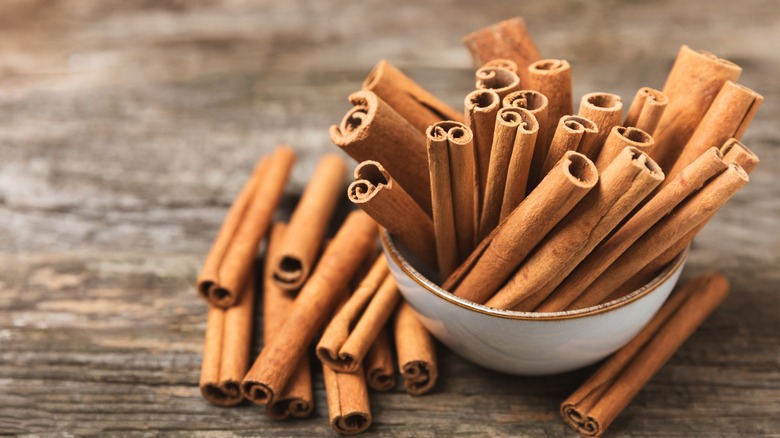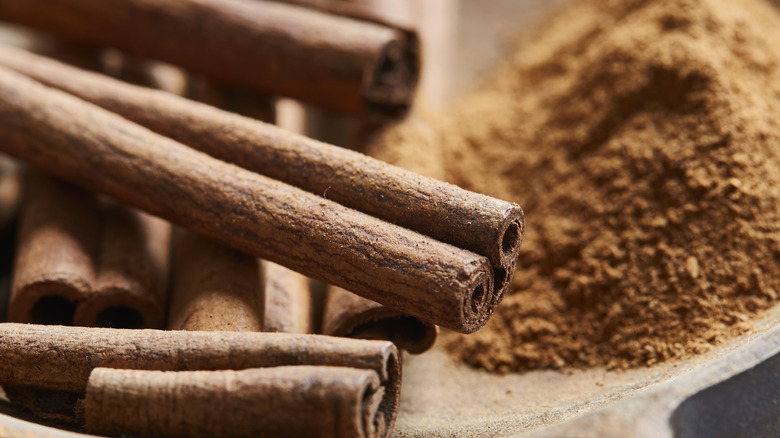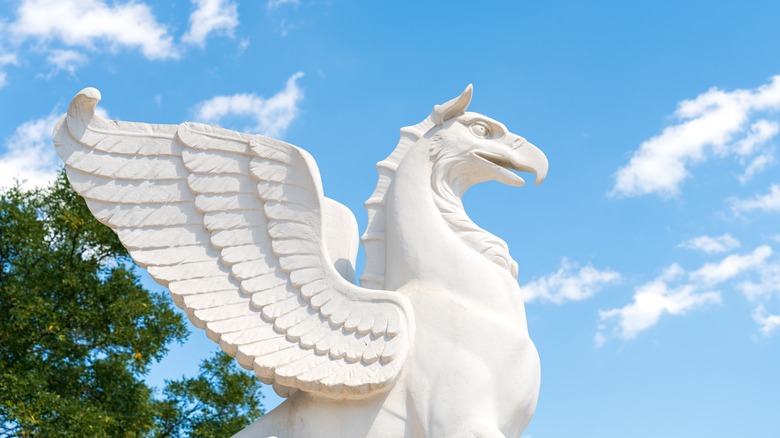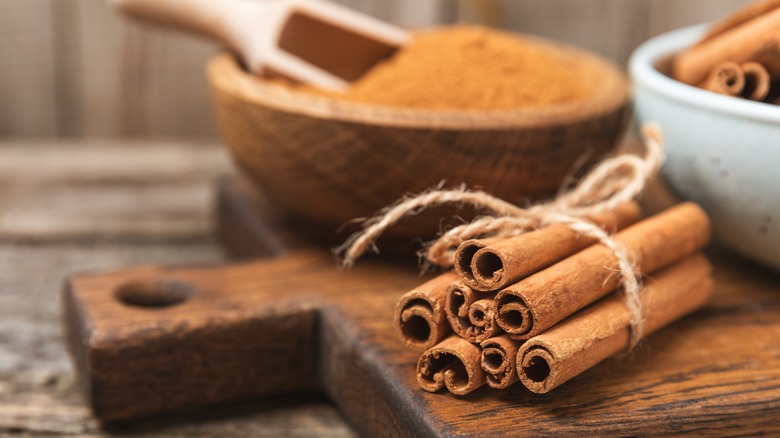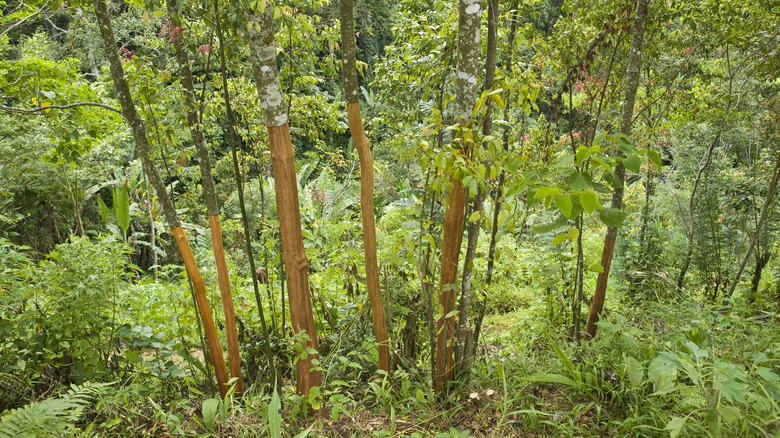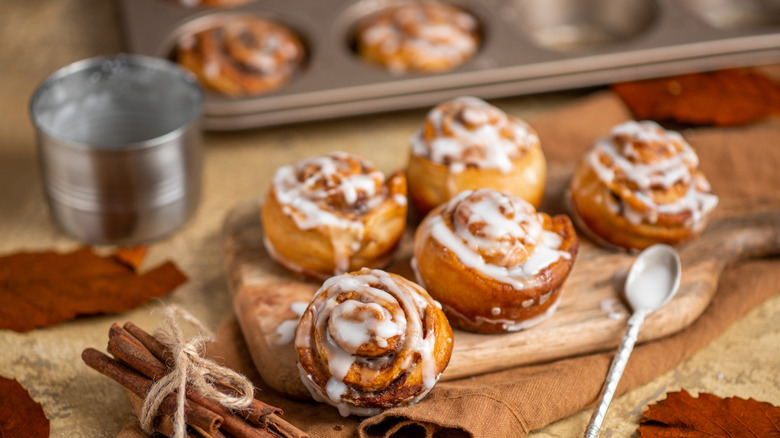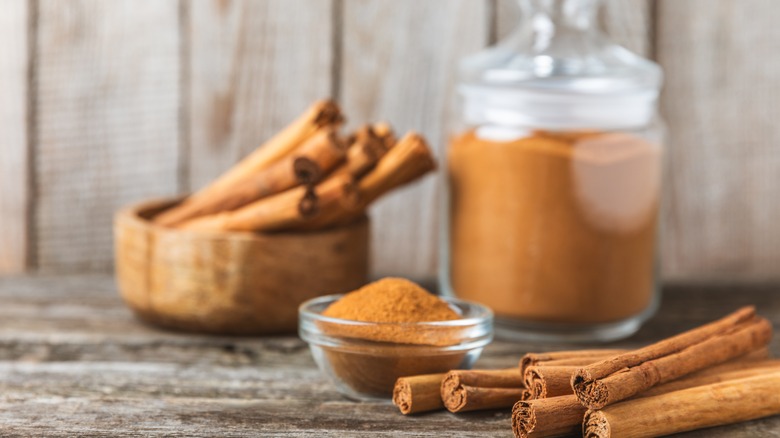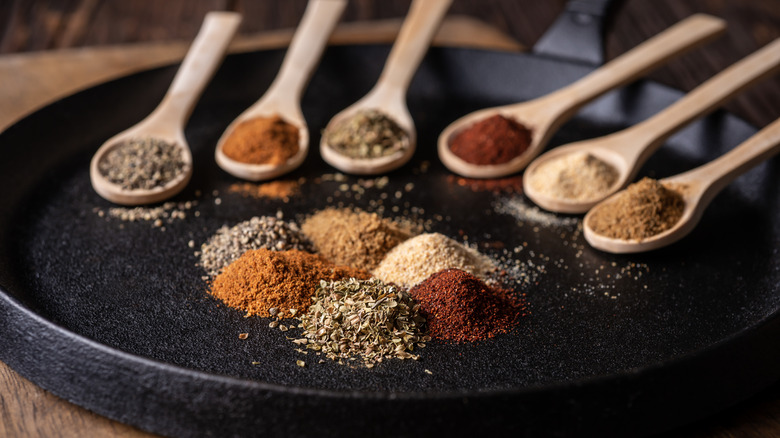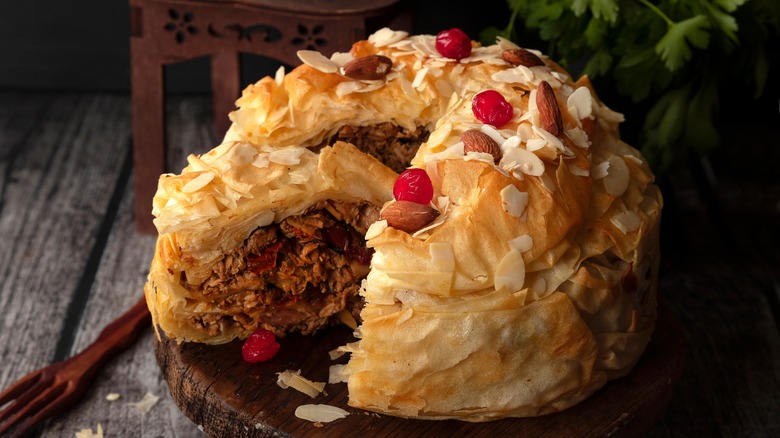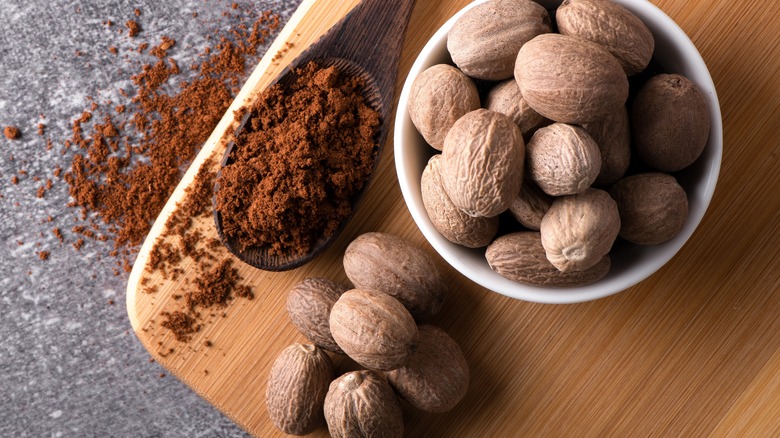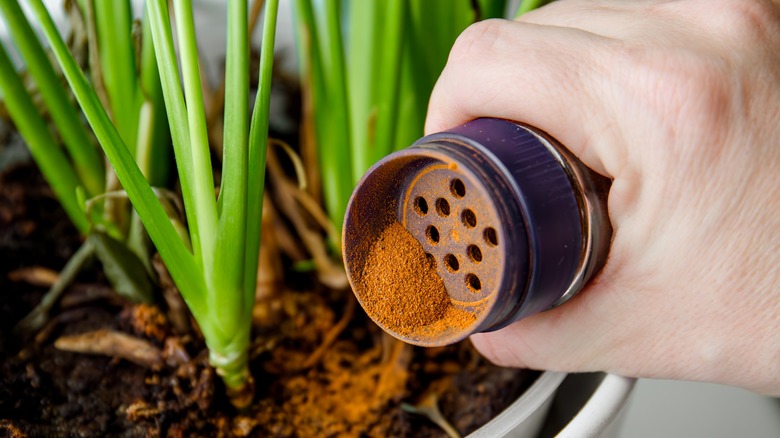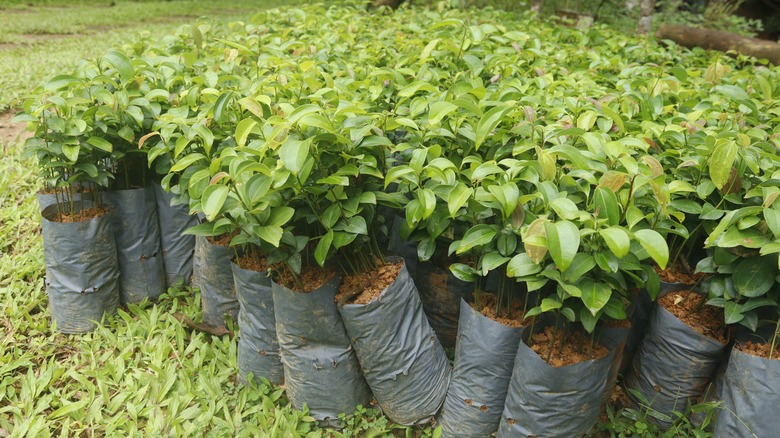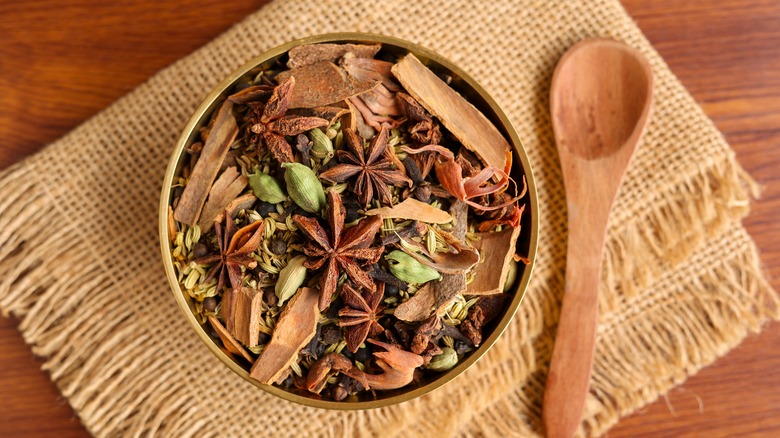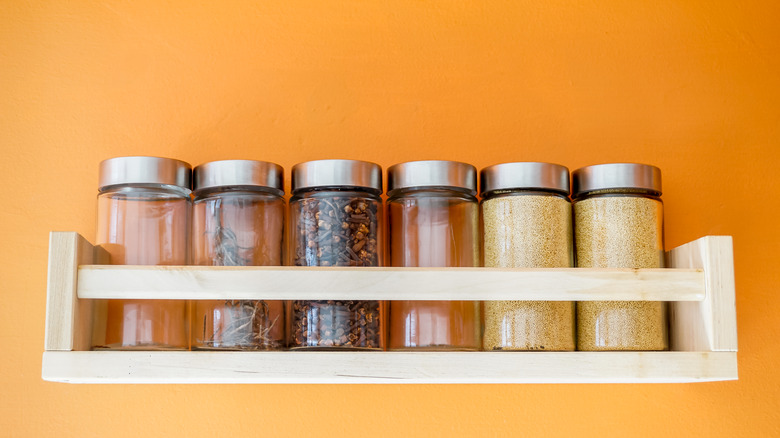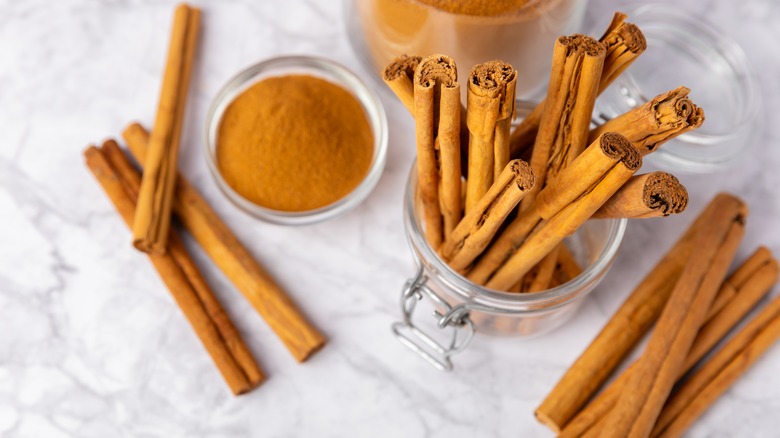The Definitive Guide To Cinnamon
If you close your eyes and imagine cinnamon, what comes to mind? For most Americans, it's a frosting-drenched roll at the bakery, a steaming mug of spiced cider, or perhaps a piece of warm gingerbread. For folks around the world, cinnamon has other connotations: spiced meat dishes in Africa, warming chili in Mexico, or stir fry in China.
Its global nature aside, cinnamon is one of the most common ingredients in the American spice arsenal, and almost every cook has a jar of it in their kitchen. But although it's easy to use (and even easy to find more upscale versions such as cinnamon sticks) for projects and dishes, many people remain unaware of its fascinating history or its more interesting uses. Yes, it's a classic Christmas flavor. But it has made its way into almost every corner of the culinary arts, and it deserves its due.
It's time to learn what this ancient spice can do in your kitchen. Whether you're a cinnamon toast fan, want to take your steel-cut oats to the next level, or are gunning to learn how to make banging tres leches pudding, this guide will help. Ditto if your culinary ventures lie further afield, in other cuisines and on other continents. That, combined with some no-nonsense rules for sourcing, storing, and using cinnamon, will make you an expert in no time.
What is cinnamon?
Cinnamon is made from the bark of the cinnamon tree, which includes several species in the Cinnamomum genus, which is a member of the Laurel family. These trees are native to South and Southeast Asia, where they grow in hot, humid climates. There are more than 250 species in the Cinnamomum genus, found across the world, but only a few varieties are cultivated for use today.
The amazing smell and flavor of cinnamon largely come from the compounds cinnamaldehyde and trans-cinnamaldehyde, present in oils in the bark. In addition to flavoring foods, cinnamon's aromatic qualities make it well-suited to perfumes, household products, and medicinal uses.
While the leaves, flowers, and roots of cinnamon trees have also been put to various uses by humans over the millennia, the generic term "cinnamon" refers to the bark itself. However, the term may encompass the bark itself, the bark when ground into a powder, or the essential oil. Note that pure cinnamon extract contains only cinnamon oil along with some water, alcohol, and glycerin (comparable to vanilla extract), while the imitation stuff contains coloring and "natural flavors," along with a decided dearth of actual cinnamon.
Myth and mystery: A history of cinnamon
Cinnamon is one of the oldest spices that was commercially produced and traded. Indeed, it may be the first spice ever recorded in Chinese history. Believe it or not, cinnamon was once more valuable than gold. The Ancient Egyptians used it in embalming, while it was a common and sacred funerary spice in Ancient Rome. The word cinnamon derives from the Arabic "amomon," which means fragrant spice plant.
By the Middle Ages, it was in full swing as a culinary spice. Europeans also used it to stimulate the appetite, aid in digestion, and even help in the bedroom. (The latter claim appears to be true, at least in elderly gentleman rats.) Some credit cinnamon as a driving force that led to European contact with the Americas, since Spain and other countries were seeking a route to the East Indies.
Throughout history, spice traders crafted tall tales to disguise the true origins of cinnamon and increase its value. Herodotus, for instance, speaks of giant birds who carry cinnamon sticks up to their nests, where they are inaccessible to humans. To deal with this, traders leave out big hunks of oxen and donkeys (you know, as one does), to encourage the birds to fly down from their nests. When they carry the meat back up, voilà! The nests break under its weight and all that glorious cinnamon comes tumbling down.
Varieties of cinnamon
There are several types of cinnamon on the market today, and only one of them is the "true" cinnamon: Cinnamomum verum, formerly Cinnamomum zeylanicum, and sometimes called Ceylon cinnamon. Its close cousin, Cassia cinnamon (Cinnamomum aromaticum), is grown in the same general part of the world, but it is actually Cassia cinnamon that comprises the bulk of the North American market.
In total, there are four varieties of culinary cinnamon: true, Cassia, Vietnamese (Cinnamomum loureiroi), and Indonesian (Cinnamomum burmannii). True cinnamon is grown in its birthplace of Sri Lanka and nearby Myanmar and India. However, it may also be grown in parts of South America and the Caribbean (West Indies) that have similar climates. Cassia cinnamon is more likely to be grown in Indonesia, as it is native to China and Southeast Asia. Vietnamese and Indonesian cinnamon are grown in their respective eponymous locations.
Note that Cassia cinnamon, true cinnamon's more common cousin, is not the real deal according to the experts. Because of this, it is sometimes referred to as fake cinnamon. However, it is not fake in the sense that imitation cinnamon is. It comes from the bark of a tree in the cinnamon genus and has plenty of cinnamon smell from the 95% cinnamaldehyde content of its oil, as opposed to only 50% to 63% in true cinnamon. Sources say that while Cassia cinnamon has plenty of flavor, though, it is not as nuanced or sweet as true cinnamon, which is better for desserts.
Modern cinnamon cultivation and production
Cinnamon trees are grown on farms in what essentially become cinnamon forests. There are several ways to grow and harvest them. They can be cut back to stumps on a two- to five-year cycle, which will cause them to produce lots of shoots and grow in a shrubby fashion. Every several years, those shoots become suitable for harvest again. This is often the case on true cinnamon plantations.
However, many commercial growers let the cinnamon grow into a full tree, which can take between 15 and 20 years. When the cinnamon tree is ready, farmers will remove strips of bark from the bottom of the tree to indicate that they are next on the chopping block... literally. Come harvest time, which happens twice a year, they cut down the tree, remove the outer bark, and harvest the under-layer of bark, which is what we know as cinnamon. This can result in nearly 80 pounds of bark from each tree, translating to between 24,000 and 32,000 pounds per acre, due to the trees' dense growth habit.
The finished product is made by letting the bark cure. As it dries, it takes on a curled shape that we know of as cinnamon sticks. This is a labor-intensive process that requires skilled workers. The smaller the sticks they can make, the more money they can fetch.
The flavor of cinnamon
Cinnamon is warm, earthy, comforting, and spicy, but not hot. In North American and European traditions, it is particularly connected with the fall season and the holidays, though in other parts of the world it is used in savory foods. Chances are good that you associate it with special dishes, drinks, or celebrations, as well as the family traditions that accompany each.
Cassia cinnamon is said to have a spicier, stronger flavor than the more mild true cinnamon. Whichever variety you buy (and it's much more likely to be Cassia, unless you're really making the effort), it will be spicy if you eat it plain, which no one in their right mind would want to do. And word to the wise: The so-called cinnamon challenge, which involves trying to consume a spoonful of cinnamon in less than a minute, is highly dangerous and should be avoided.
Available forms of cinnamon
There are many ways to use cinnamon in your cooking and many forms in which it comes. Most commonly, you will see it available as sticks, also called quills, or ground into powder. In these forms, it can be available in bags, jars, or plastic containers. These are readily found at the average grocery store. Sometimes grocery stores (and more commonly specialty shops) will offer smaller pieces, variously and adorably known as quillings, featherings, and chips, depending on their size. These may cost less than whole sticks.
You can also find cinnamon as an essential oil, but be wary of how you use it. Essential oils are much stronger than regular cooking oil and you have to know what you're doing, either adding it in small drops to dishes or using a carrier oil for household preparations (think homemade skin products).
Cinnamon-flavored ingredients, such as cinnamon syrup, are also yummy if you're making sweet treats, but they are never pure cinnamon. Always check the other ingredients before using; at the least, a syrup will contain sugar and may have other additives. Many common spice mixtures use cinnamon, such as apple pie or pumpkin pie spice.
How to choose the best spices
To choose the best spices, look for reputable brands that carry several other types of spices, and they can tell you where they sourced them from. In the store, seek out bright spices that have a lot of color and, if in bulk, smell quite fragrant. Avoid anything that is past its best-by date. It won't kill you, but it will have lost a lot of its fragrance. Ethnic food stores are often a good place to buy fresh spices at reasonable prices.
If it is ground, make sure you don't see any clumps, and check the ingredients label to ensure you're buying cinnamon and only cinnamon, rather than fillers or additives. Although anti-caking agents may help keep the powder from clumping, they also dilute the potency of the spice. Your best bet is to replace your cinnamon often rather than buying it with additives. If you care or if it matters to your recipe, make sure also to check whether you're buying Cassia or true cinnamon.
Common uses for cinnamon in the kitchen
Cinnamon is hugely popular in a range of different dishes and cuisines. It is used in sweet treats from cinnamon rolls to gingerbread, in savory dishes from Moroccan chicken pie to Indian butter chicken or beef chili, and in drinks from Mexico's famous horchata to mulled wine. There are all kinds of creative ways to use cinnamon sticks, too.
Speaking of everyone's favorite Sunday treat, did you know you don't need to make your cinnamon rolls from scratch in order to get them to taste that way? You can use several hacks to fake the homemade quality of canned cinnamon rolls (if you want to fool your guests, we won't tell). For instance, you can add heavy cream to cinnamon rolls before baking, brush them with butter, or make a cinnamon crumble topping using readily available pantry ingredients. These are all easy ways to take brunch from boring to brilliant.
Wondering if grinding your own cinnamon is a good idea? The answer is yes, and there are myriad of ways to do it. You can grind sticks to powder using a microplane zester, mortar and pestle, or Ziplock bag and meat tenderizer. If you prefer to let electricity do the work, you can use a blender, spice grinder, coffee grinder, or food processor, though food processors tend to be touchy. This writer hasn't had much success with high-speed blenders, either.
Substitutes for cinnamon
There are several substitutes for cinnamon, most of which hail from the same climates. Think nutmeg, allspice, ginger, cardamom, cloves, or mace, all of which will lend an earthy warmth like cinnamon does. A cinnamon stick also works, freshly grated using a microplane or zester. Because the flavor is so much more potent, though, be sure to only use ¼ of the amount of ground cinnamon called for in the recipe. The same goes for when you are substituting other spices; always look up the proper substitution amount, as it frequently isn't 1-to-1.
You can also use a spice mix of which cinnamon is a component, such as pumpkin or apple pie seasoning. Again, always research how much to use, which will depend on the type of substitution and the form you're using (ground, whole, or oil). If necessary, you can leave cinnamon out of the recipe altogether, although it may lose something if you do. This is a better bet when there are other spices at play if you want to avoid a bland result, though.
Other uses for cinnamon at home
Due to its antimicrobial properties, cinnamon is a useful ingredient in home remedies. You can apply it to a toothbrush to aid in the healing of mouth sores, soak feet to fight fungus, or use it to combat bloating.
It is also an anti-fungal agent to help kill household mushrooms. If you see white fuzz or those yellow caps pop up in the soil of your houseplants, all you have to do is sprinkle cinnamon on top of them and wait a day or two. It will take care of the problem pronto. Don't worry so much about the amount you use as about covering the fungus fully. This also works for mold, ants, and other pests in your home or greenhouse. If you prefer, you can mix cinnamon into water to make a spray.
Additionally, cinnamon works as part of a natural household cleaner. To make it, put orange peels in a Mason jar and throw in a few cinnamon sticks, then cover the whole with vinegar. Allow the mixture to sit in a dark place for about two weeks before straining it into a spray bottle for use on household surfaces. Just make sure to check which surfaces can handle vinegar before use.
Growing your own cinnamon
Native to Asia, cinnamon trees require warm weather in which to thrive. Fortunately, some parts of the United States do have weather warm enough. Some sources say you can grow your own cinnamon tree if you live in USDA zones 9 to 11 and have a warm, sunny spot in which to plant it. Others caution that you need warmer climes, between USDA zones 10 to 12. If you live in zone 9 or above, it's worth at least trying.
Make sure to provide good drainage and keep the tree evenly moist. Cinnamon trees like loamy soil (as opposed to clay or sand in large amounts), and they want a pH that's acidic to neutral. They flower in summer, offering pretty, waxy, yellow or white blossoms. When you're ready to harvest your cinnamon, you can either prune off branches to use or cut down the entire tree. If you do, wait to see if shoots come back up from the stump, which you may be able to harvest again and again. The typical timeframe for harvesting is every two years or so, after the initial two to three years it takes for the tree to become established.
Health benefits of cinnamon
Cinnamon has been used in traditional medicine for hundreds or thousands of years and contains a variety of beneficial compounds that are available to you whether you consume it in food or as a supplement. It may help boost antioxidants, provide anti-inflammatory properties, fight cancer, lower cholesterol, combat heart disease, and more.
It's not hard to get these benefits for yourself, moreover. According to the U.S. Department of Agriculture (USDA), cinnamon is healthy when consumed in amounts of ½ teaspoon a day or less. Do that, and you can see improvements in both blood sugar and cholesterol, according to recent studies in humans.
Do note that getting these compounds requires you to consume cinnamon solids rather than cinnamon oil, which doesn't contain the same active compounds that lead to health benefits. As such, you can add ground cinnamon to food or use the sticks to make tea.
Storing cinnamon to last
Cinnamon will last for a long time if properly stored. Always keep it in an airtight jar in a cool, dry place away from sunlight. The insides of cupboards, pantries, and drawers are always a good bet. If you're going to keep your spices on a rack in the kitchen, make sure the rack isn't in direct sunlight. Because spices are photosensitive, they are degraded by light, which breaks them down and begins to destroy their flavor.
The good news is that spices do not spoil in the traditional sense, meaning they harbor pathogens. They will remain safe to eat pretty much forever, but they will begin to lose their flavor. Ground spices lose their flavor more quickly than whole spices due to the fact that they have much more exposed surface area through which the flavoring agents can evaporate. For best flavor, keep ground spices for three years maximum, four years if they are whole. Because ground spices lose their flavor more quickly, it may be worth the investment to figure out how to grind your own.
Nutritional information
Cinnamon is low in calories, containing less than 7 calories per teaspoon. It's certainly a healthy food in that respect, though it contributes little in the way of protein, fat, or carbohydrates. It does, however, contain 5% of your daily value of fiber in that teaspoon, so that's something.
A bigger benefit of cinnamon is the variety of vitamins and minerals it contains. You'll get iron, magnesium, calcium, phosphorous, potassium, and vitamin A, as well as a variety of other trace nutrients, which add up over time.
There are a few dangers of consuming too much cinnamon to be aware of, though. These risks include liver damage, mouth sores, low blood sugar, or breathing problems. Also, in higher amounts, it may interact with medications negatively. Always ask your doctor before using cinnamon as a supplement to make sure it's okay, though you most likely don't have to worry about ordinary amounts in cooking. When in doubt, stick to ½ teaspoon a day or less, per the USDA.
